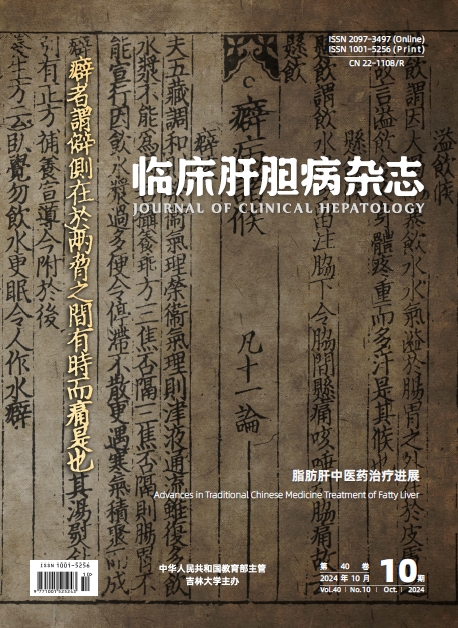| [1] |
YOUNOSSI ZM, KOENIG AB, ABDELATIF D, et al. Global epidemiology of nonalcoholic fatty liver disease-Meta-analytic assessment of prevalence, incidence, and outcomes[J]. Hepatology, 2016, 64( 1): 73- 84. DOI: 10.1002/hep.28431. |
| [2] |
MAN S, DENG YH, MA Y, et al. Prevalence of liver steatosis and fibrosis in the general population and various high-risk populations: A nationwide study with 5.7 million adults in China[J]. Gastroenterology, 2023, 165( 4): 1025- 1040. DOI: 10.1053/j.gastro.2023.05.053. |
| [3] |
Diagnosis and Treatment Center of Hepatology of South China Alliance of TCM, National Administration of Traditional Chinese Medicine. Diagnosis and treatment scheme of Ganpi(non-alcoholic steatohepatitis)[J/CD]. Chin J Liver Dis Electron Version, 2021, 13( 1): 1- 9. DOI: 10.3969/j.issn.1674-7380.2021.01.001. |
| [4] |
WANG WJ. Prevention and treatment of metabolic syndrome with integrated traditional Chinese and western medicine[J]. J Chin Integr Med, 2004, 2( 5): 390- 395. DOI: 10.3736/jcim20040524. |
| [5] |
|
| [6] |
|
| [7] |
TONG XL, ZHANG ZY. Understanding and treatment of metabolic syndrome in traditional Chinese medicine[J]. J Tradit Chin Med, 2002, 43( 9): 708- 709. DOI: 10.13288/j.11-2166/r.2002.09.052. |
| [8] |
ZHAO TY, DUAN J, TONG XL. New thinking of treating diabetes with traditional Chinese medicine[J]. J Tradit Chin Med, 2002, 17( 5): 12- 13. DOI: 10.3969/j.issn.1003-8914.2002.05.009. |
| [9] |
HU SP. Discussion on treating fatty liver from six stagnation diseases[J]. J Pract Tradit Chin Med, 2015, 31( 12): 1184- 1185.
胡四平. 浅述从六郁论治脂肪肝[J]. 实用中医药杂志, 2015, 31( 12): 1184- 1185
|
| [10] |
PAN XM. Pathogenesis and clinical investigation of metabolic syndrome based on six stagnation theory[D]. Jinan: Shandong University of Traditional Chinese Medicine, 2009.
潘小梅. 基于六郁理论对代谢综合征的病机探讨与临床调研[D]. 济南: 山东中医药大学, 2009.
|
| [11] |
TANG FR. Clinical observation on 62 cases of fatty liver treated with Chaihu Shugan powder[J]. J Sichuan Tradit Chin Med, 2008, 26( 4): 82- 83.
唐方荣. 柴胡疏肝散加减治疗脂肪肝62例临床观察[J]. 四川中医, 2008, 26( 4): 82- 83.
|
| [12] |
SU JC. Clinical observation on treatment of fatty liver with Gexia Zhuyu decoction[J]. Heilongjiang J Tradit Chin Med, 2006, 35( 4): 35- 36.
苏建超. 膈下逐淤汤治疗脂肪肝的临床观察[J]. 黑龙江中医药, 2006, 35( 4): 35- 36.
|
| [13] |
CHEN YL, CHANG JG. Jiawei Weiling Decoction in treating 56 cases of hyperlipidemia of spleen deficiency, phlegm dampness and middle stagnation[J]. J Sichuan Tradit Chin Med, 2008, 26( 11): 85.
陈佑林, 常建国. 加味胃苓汤治疗脾虚痰湿中阻型高脂血症56例[J]. 四川中医, 2008, 26( 11): 85.
|
| [14] |
ZHANG AL. Discussion on the formation of phlegm-heat and it’s causative mechanism[J]. China J Basic Med Tradit Chin Med, 2005, 11( 5): 388- 390. DOI: 10.3969/j.issn.1006-3250.2005.05.027. |
| [15] |
|
| [16] |
YANG DQ. 50 cases of severe fatty liver treated by Longdan Xiegan decoction combined with acupoint application therapy[J]. Guangming J Chin Med, 2008, 23( 3): 306- 307. DOI: 10.3969/j.issn.1003-8914.2008.03.028. |
| [17] |
TANG HH, WEI CS, ZHENG YJ, et al. Evaluating the clinical effect of modified Shugan Xiaozhi Decoction in treating nonalcoholic fatly liver disease based on fibro scan technique[J]. J Tradit Chin Med, 2018, 59( 7): 594- 598. DOI: 10.13288/j.11-2166/r.2018.07.014. |
| [18] |
YANG HL, FENG L, XU LY, et al. Intervention of Shugan Xiaozhi Decoction on nonalcoholic fatty liver disease via mediating gut-liver axis[J]. Biomed Res Int, 2022, 2022: 4801695. DOI: 10.1155/2022/4801695. |
| [19] |
XING YF, ZHANG Z, FU WJ, et al. Shugan Xiaozhi Decoction attenuates nonalcoholic steatohepatitis by enhancing PPAR α and L-FABP expressions in high-fat-fed rats[J]. Evid Based Complement Alternat Med, 2016, 2016: 7870189. DOI: 10.1155/2016/7870189. |
| [20] |
YANG R, YANG HL, JIANG DS, et al. Investigation of the potential mechanism of the Shugan Xiaozhi decoction for the treatment of nonalcoholic fatty liver disease based on network pharmacology, molecular docking and molecular dynamics simulation[J]. PeerJ, 2022, 10: e14171. DOI: 10.7717/peerj.14171. |
| [21] |
CHEN MT, HUANG FR, CHEN BH, et al. A classical herbal formula alleviates high-fat diet induced nonalcoholic steatohepatitis(NASH) via targeting mitophagy to rehabilitate dysfunctional mitochondria, validated by UPLC-HRMS identification combined with in vivo experiment[J]. Biomedecine Pharmacother, 2023, 168: 115831. DOI: 10.1016/j.biopha.2023.115831. |
| [22] |
WANG S, CHEN BH, DU RL, et al. An herbal formulation“Shugan Xiaozhi decoction” ameliorates methionine/choline deficiency-induced nonalcoholic steatohepatitis through regulating inflammation and apoptosis-related pathways[J]. J Ethnopharmacol, 2024, 329: 118127. DOI: 10.1016/j.jep.2024.118127. |







 DownLoad:
DownLoad: